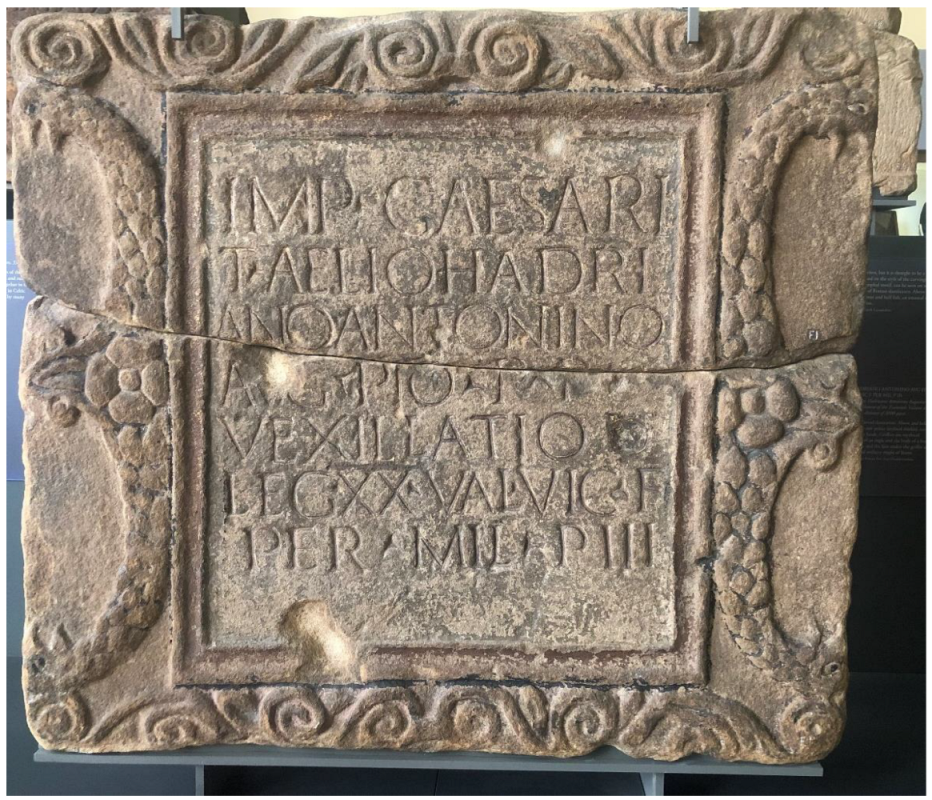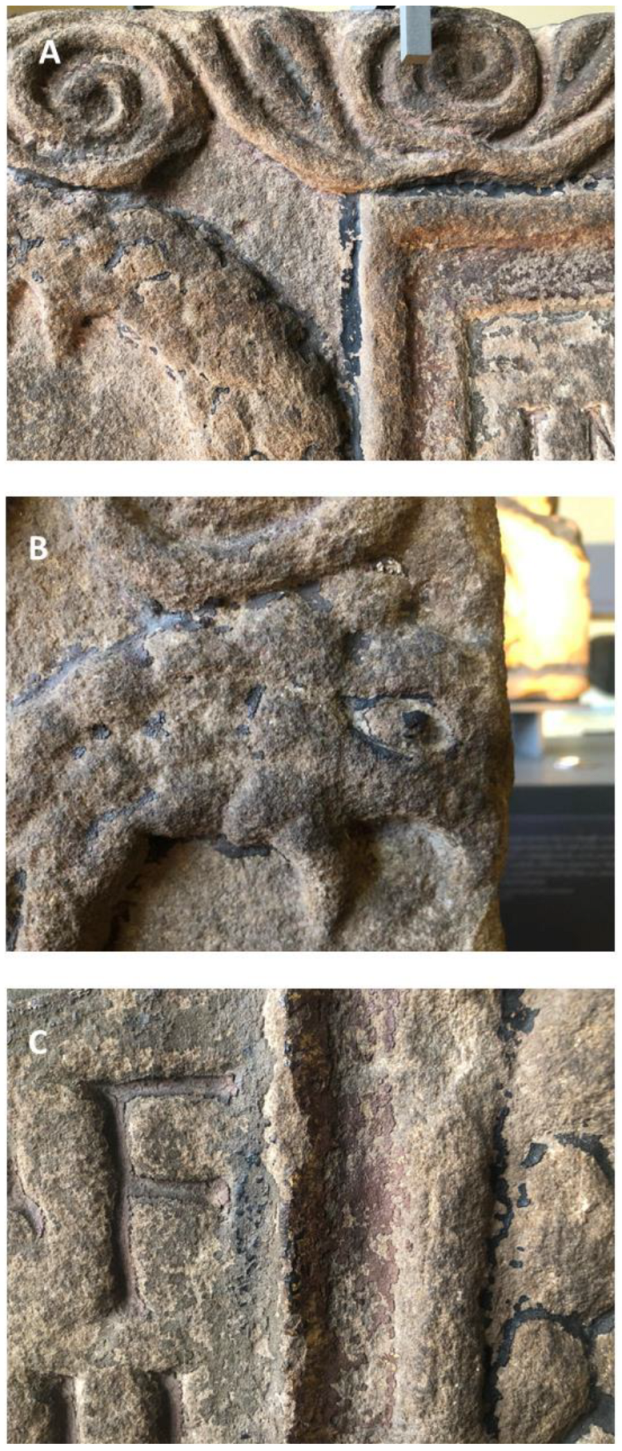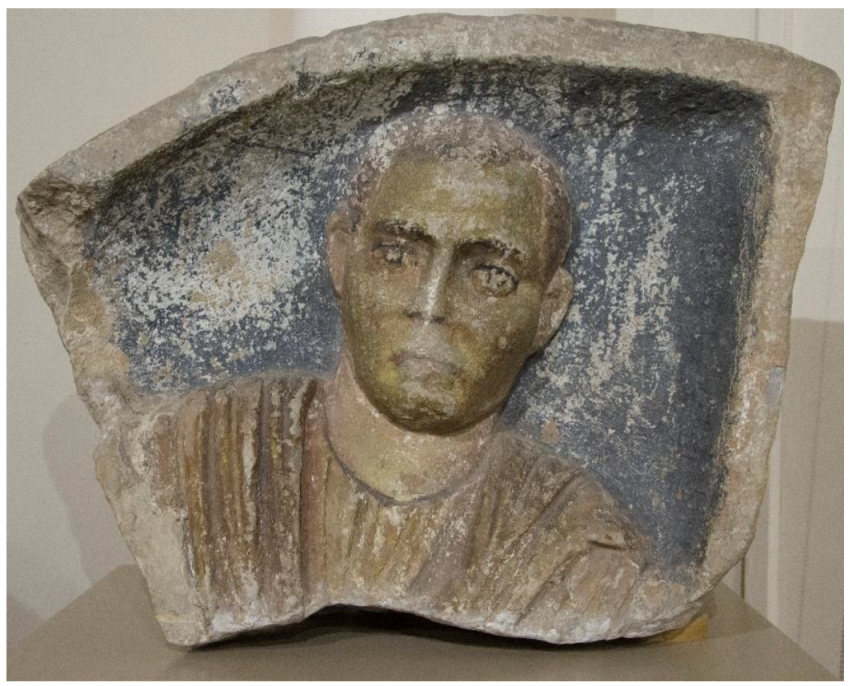Tracking Trajectories: Projecting Polychromy onto a Roman Relief from a Scottish Castle
Abstract
1. Introduction
2. Tracking the Trajectory of a Roman Distance Sculpture (GLAHM.F1)
3. Polychromy on GLAHM.F1
4. Materials Science Methods
5. Summary of Scientific Analysis Results
5.1. Ivy Tendrils
5.2. Griffin Peltae
5.3. Griffin Eye
5.4. Inscription Panel Frame
5.4.1. Exterior Frame
5.4.2. Gilded Frame
5.4.3. Informal Border Inside Inscription Panel Frame
5.5. Inscription Panel Background
5.6. Inscribed Letters
5.7. Artillery Damage
5.8. The Palette
6. Digital Reconstruction
7. Discussion and Conclusions
Funding
Data Availability Statement
Acknowledgments
Conflicts of Interest
References
- Hanson, W.S.; Maxwell, G.S. Rome’s North West Frontier: The Antonine Wall; Edinburgh University Press: Edinburgh, UK, 1983. [Google Scholar]
- Breeze, D.J. The Antonine Wall; Birlinn: Edinburgh, UK, 2015. [Google Scholar]
- Robertson, A.S. The Antonine Wall. A Handbook to Scotland’s Roman Frontier, 6th ed.; Keppie, L.J.F., Ed.; Glasgow Archaeological Society: Glasgow, UK, 2015. [Google Scholar]
- Macdonald, G. The Roman Wall in Scotland; James Maclehose and Sons: Glasgow, UK, 1911. [Google Scholar]
- Ferris, I.M. Enemies of Rome: Barbarians through Roman Eyes; Sutton Publishing: Stroud, UK, 2000. [Google Scholar]
- Campbell, L. Reading the Writing on the Wall: Discovering new dimensions to the Antonine Wall Distance Stones. J. Anc. Hist. Archaeol. 2020, 7, 777–780. Available online: http://jaha.org.ro/index.php/JAHA/article/view/513 (accessed on 11 April 2023). [CrossRef]
- Campbell, L. Polychromy on the Antonine Wall Distance Sculptures: Non-destructive identification of pigments on Roman Reliefs. Britannia 2020, 51, 175–201. [Google Scholar] [CrossRef]
- Keppie, L.J.F. Roman Distance Slabs from the Antonine Wall: A Brief Guide; Hunterian Museum: Glasgow, UK, 1979. [Google Scholar]
- Collingwood, R.G.; Wright, R.P. The Roman Inscriptions of Britain; Clarendon Press: Oxford, UK, 1965; Volume 1, Available online: https://romaninscriptionsofbritain.org/ (accessed on 11 April 2023).
- Campbell, L.; Smith, M. Multi-technique analysis of pigments on sandstone sculptures: Renaissance re-painting of a Roman relief. Herit. Sci. 2022, 10, 156. [Google Scholar] [CrossRef]
- Keppie, L.J.F. Roman Inscribed and Sculptured Stones in the Hunterian Museum, University of Glasgow; Society for the Promotion of Roman Studies: London, UK, 1998. [Google Scholar]
- Keppie, L.J.F. The distance slabs from the Antonine Wall: Some problems. Scott. Archaeol. Forum 1976, 7, 57–66. [Google Scholar]
- Gordon, A. Itinerarium Septentrionale; Gale: Detroit, MI, USA, 2018. [Google Scholar]
- Macdonald, G. The Roman Wall in Scotland, 2nd ed.; Clarendon Press: Oxford, UK, 1934. [Google Scholar]
- Camden, W. Britannia; Impensis Gerogii Bishop & Ioannis Norton: London, UK, 1607. [Google Scholar]
- Gibson, E. Camden’s Britannia: Newly Translated into English: With Large Additions and Improvements; F. Collins: London, UK, 1695. [Google Scholar]
- Macfarlane, W. Geographical Collections; Scottish Historical Society: Edinburgh, UK, 1908; Volume 53. [Google Scholar]
- Shepherd, I.A.G. Exploring Scotland’s Heritage: Grampian, Exploring Scotland’s Heritage Series; RCAHMS: Edinburgh, UK, 1986.
- Keppie, L.J.F. The Antiquarian Rediscovery of the Antonine Wall; Society of Antiquaries of Scotland: Edinburgh, UK, 2012. [Google Scholar]
- Horsley, J. Britannia Romana or the Roman Antiquities of Britain; John Osborn and Thomas Longman: London, UK, 1732. [Google Scholar]
- Anderson, J. Of the Roman Wall between the Forth & Clyde; and of Some Discoveries which Have Lately Been Made Upon it; Andersonian Library, University of Strathclyde: Glasgow, UK, 1771. [Google Scholar]
- Stuart, R. Caledonia Romana: A Descriptive Account of the Roman Antiquities of Scotland; Preceded by an Introductory View of the Aspect of the Country and State of Its Inhabitants in the First Century of the Christian Era; and by a Summary of the Historical Transactions Connected with the Roman Occupation of North Britain; Bell & Bradfute: Edinburgh, UK, 1845. [Google Scholar]
- Peacham, H. Compleat Gentleman 1634; Clarendon Press: Oxford, UK, 1906. [Google Scholar]
- Beodsky-Porges, E. The grand tour travel as an educational device 1600–1800. Ann. Tour. Res. 1981, 8, 171–186. [Google Scholar] [CrossRef]
- Chaney, E. The Evolution of the Grand Tour: Anglo-Italian Cultural Relations since the Renaissance; Routledge: London, UK; New York, NY, USA, 1998. [Google Scholar]
- Birch, D. Courtesy literature. In The Oxford Companion to English Literature, 7th ed.; Oxford University Press: Oxford, UK, 2009. [Google Scholar]
- Posner, D.M. The Performance of Nobility in Early Modern European Literature; Cambridge University Press: Cambridge, UK, 1999. [Google Scholar]
- Moreno, E.Z.; Puig, J.M. Propuesta de la policromía del Augusto de Prima Porta: Hipótesis naturalista y metodología procedimental. Revista PH 2021, 102, 40–55. [Google Scholar] [CrossRef]
- Bartman, E. Collecting in Premodern Europe. In The Oxford Handbook of Roman Sculpture; Friedland, E.A., Sobocinski, M.G., Gazda, E.K., Eds.; Oxford University Press: Oxford, UK, 2015; pp. 13–26. [Google Scholar]
- Faedo, L. The Post-Antique Reception of Greek and Roman Art and Architecture. In The Oxford Handbook of Greek and Roman Art and Architecture; Marconi, C., Ed.; Institute of Fine Arts, New York University: New York, NY, USA, 2014; pp. 417–439. [Google Scholar]
- Podany, J. Conservation and restoration. In The Oxford Handbook of Roman Sculpture; Friedland, E.A., Sobocinski, M.G., Gazda, E.K., Eds.; Oxford University Press: Oxford, UK, 2015; pp. 27–43. [Google Scholar]
- Vout, C. Classical Art: A Life History from Antiquity to the Present; Princeton University Press: Princeton, NJ, USA, 2018. [Google Scholar]
- Cubbage, J. The Cawder Story: The Story of Cawder Golf Club; Cawder Golf Club: Glasgow, UK, 1984. [Google Scholar]
- Hübner, E. CIL VII, Inscriptiones Britanniae Latinae/Consilio et Auctoritate Academiae Litteraru Regiae; Reiner: Berolini, Germany, 1873. [Google Scholar]
- Fabretti, R. Inscriptionum Antiquarum Quae in Aedibus Paternis Asservantur Explicatio et Additamentum; Sumptibus Francisci Ant. Galleri: Rome, Italy, 1699. [Google Scholar]
- Gibb, A. New Measurement of the Vallum of Antoninus Pius, Northern Notes and Queries; University of Glasgow: Glasgow, UK, 1902; Volume 63, pp. 17–26. [Google Scholar]
- Furlotti, B. Antiquities in Motion: From Excavation Sites to Renaissance Collections; Getty Publications: Los Angeles, CA, USA, 2019. [Google Scholar]
- True, M. Changing approaches to conservation. In History of Restoration of Ancient Stone Sculptures; Grossman, J.B., Podany, J., True, M., Eds.; Getty Publications: Los Angeles, CA, USA, 2003; pp. 1–11. [Google Scholar]
- Podany, J. Lessons from the Past. In History of Restoration of Ancient Stone Sculptures; Grossman, J.B., Podany, J., True, M., Eds.; Getty Publications: Los Angeles, CA, USA, 2003; pp. 13–24. [Google Scholar]
- Jenkins, I. Cleaning and Controversy: The Parthenon Sculptures 1811–1939. In British Museum Occasional Paper 146; British Museum: London, UK, 2001. [Google Scholar]
- Jenkins, I.; Middleton, A. 1988: Paint on the Parthenon sculptures. Annu. Br. Sch. Athens 1988, 83, 183–207. [Google Scholar] [CrossRef]
- Ellis, L. Raffaello Borghini’s Il Riposo: A Critical Study and Annotated Translation. Unpublished Dissertation. Case Western Reserve University: Ann Arbor, MI, USA, August 2002. [Google Scholar]
- Østergaard, J.S. The Polychromy of Antique Sculpture: A Challenge to Western Ideals? In Circumlitio: The Polychromy of Antique and Mediaeval Sculpture; Brinkmann, V., Primavesi, O., Hollein, M., Eds.; Himer Verlag: Munich, Germany, 2010; pp. 78–104. [Google Scholar]
- Abbe, M.; Verri, G. The “Bursa Relief”: A Non-Invasive Analytical Investigation of an Exceptionally Painted Roman Marble Portrait. In Polychromy in Ancient Sculpture and Architecture; Bracci, S., Giachi, G., Liverani, P., Pallecchi, P., Paolucci, F., Eds.; Le Gallerie Degli Uffizi: Florence, Italy, 2018; pp. 167–182. [Google Scholar]
- Keppie, L.J.F. Understanding Roman Inscriptions; B. T. Batsford Ltd.: London, UK, 1991. [Google Scholar]
- Harley, R.D. Artists’ Pigments c. 1600–1835: A Study in English Documentary Sources, 2nd ed.; Archetype Publications: London, UK, 2001. [Google Scholar]
- Winter, J.; Fitzhugh, E.W. Pigments based on carbon. Artists’ Pigments: A Handbook of Their History and Characteristics; National Gallery of Art: Washington, DC, USA, 2007; Volume 4, pp. 1–37.
- McGlinchey, C. Handheld XRF for the examination of paintings: Proper use and limitations. In Handheld XRF for Art and Archaeology; Shugar, A.N., Mass, J.L., Eds.; Leuven University Press: Leuven, Belgium, 2013; pp. 131–158. [Google Scholar]
- Donais, M.K.; George, D.B. X-ray Fluorescence Spectrometry and Its Applications to Archaeology: An Illustrated Guide; Momentum Press: New York, NY, USA, 2018. [Google Scholar]
- Spring, M. New insights into the materials of fifteenth-and sixteenth-century Netherlandish paintings in the National Gallery, London. Herit. Sci. 2017, 5, 40. [Google Scholar] [CrossRef]
- Richter, M. Art technological source research and scientific examination: A comparative study on the technique of coloured glazes applied to metal leaf. In Lüsterfassungen des Barock und Rokoko. Coloured Glazes on Metal Leaf from the Baroque and Rococo; Kühlenthal, E.E.M., Richterm, M., Eds.; Anton Siegl Fachbuchhandlung: München, Germany, 2013; pp. 39–84. [Google Scholar]
- Félibien, A. Des Principes de L’architecture, de la Sculpture, de la Peinture, et des Autres Arts qui en Dependent. Avec un Dictionnaire des Termes Propres à Chacun des ces Arts; Jean-Baptiste Coignard: Paris, France, 1676; pp. 281–291. [Google Scholar]
- Bartl, A.; Krekel, C.; Lautenschlager, M.; Oltrogge, D. Der “Liber illuministarum” aus Kloster Tegernsee, Edition, Übersetzung and Kommentar der Kunsttechnologischem Rezepte; Franz Steiner: Stuttgart, Germany, 2005. [Google Scholar]
- Seidensticker, P. Mittelniederdeutsche Mal- und Färberrezepte aus der Niedersächsischen Staats- und Universitätsbibliothek Göttingen. In Gedenkschrift für Heinrich Wesche; Kramer, W., Scheuermann, W., Stellmacher, D., Eds.; Karl Wachholtz: Neumünster, Germany, 1979; pp. 287–304. [Google Scholar]
- Powell, C.; Allen, Z. Italian Renaissance Frames at the V&A; Elsevier: London, UK, 2010. [Google Scholar]
- Nadolny, J. All that’s burnished isn’t bole. Reflections on medieval water gilding, part 1: Early medieval to 1300. In Medieval Painting in Northern Europe: Techniques, Analysis, Art History: Studies in Commemoration of the 70th Birthday of Unn Plahter; Plahter, U., Nadolny, J., Kollandsrud, K., Eds.; Archetype Publications: London, UK, 2006; pp. 148–162. [Google Scholar]
- Mühlethaler, B.; Thissen, J. Smalt. In Artists’ Pigments. A Handbook of Their History and Characteristics; Roy, A., Ed.; Oxford University Press: New York, NY, USA, 1993; Volume 2, pp. 113–130. [Google Scholar]
- Robinet, L.; Spring, M.; Pagés-Camagna, S. Vibrational spectroscopy correlated with elemental analysis for the investigation of smalt pigment and its alteration in paintings. Anal. Methods 2013, 5, 4628–4638. [Google Scholar] [CrossRef]
- Boon, J.J.; Keune, K.; van der Weerd, J.; Geldof, M.; van Asperen de Boer, J.R.J. Imaging Microspectroscopic, Secondary Ion Mass Spectrometric and Electron Microscopic Studies on Discoloured and Partially Discoloured Smalt in Cross-sections of 16th Century Paintings. Chim. Int. J. Chem. 2001, 55, 952–960. [Google Scholar] [CrossRef]
- Tyler, M.J. Aspects of the Manufacture, Trade and History of Smalt. Ph.D. Thesis, University of Glasgow, Glasgow, UK, 20 April 2021. [Google Scholar]
- Easthaugh, N.; Walsh, V.; Chaplin, T.; Siddall, R. Pigment Compendium: A Dictionary and Optical Microscopy of Historical Pigments; Routledge: London, UK; New York, NY, USA, 2013. [Google Scholar]
- Kugler, V.; Spring, M.; Hudson, J. Quantitative SEM-EDX Analysis of Smalt Pigment Under Variable Pressure Conditions. Proc. Microsc. Microanal. 2013, 19 (Suppl. S2), 1428–1429. [Google Scholar] [CrossRef]
- van Loon, A.; Noble, P.; de Man, D.; Alfred, M.; Callewaert, T.; Van der Snickt, G.; Janssens, K.; Dik, J. The role of smalt in complex pigment mixtures in Rembrandt’s Homer 1663: Combining MA-XRF imaging, microanalysis, paint reconstructions and OCT. Herit. Sci. 2020, 8, 90. [Google Scholar] [CrossRef]
- Robinet, L.; Spring, M.; Pagés-Camagna, S. Investigation of the loss of colour in smalt on degradation in paintings using multiple spectroscopic analytical techniques. In Proceedings of the ICOM Commit- Tee for Conservation 16th Triennial Meeting, Lisbon, Portugal, 19–23 September 2011; Available online: https://hal.archives-ouvertes.fr/hal-03028072 (accessed on 30 May 2022).
- Kunckel, J. Ars Vitraria Experimentalis Oder Vollkommene Glasmacher-Kunst; Selbstverlag: Frankfurt, Germany, 1679; pp. 366–367. [Google Scholar]
- Stone, I. The Thomas Sutton Memorial in Charterhouse Chapel. 2019. Available online: https://ianstone.london/2019/03/18/the-thomas-sutton-memorial-in-charterhouse-chapel// (accessed on 30 May 2022).
- Simon, J. The Art of the Picture Frame: Artists, Patrons and the Framing of Portraits in Britain; National Portrait Gallery: London, UK, 1996. [Google Scholar]
- Scott, J. The Pleasures of Antiquity; Yale University Press for the Paul Mellon Centre for Studies in British Art: New Haven, CT, USA, 2004. [Google Scholar]
- Apted, M.R. Painting in Scotland from the 14th to the 17th Centuries, with Particular Reference to Painted Domestic Decoration, 1550–1650. Ph.D. Thesis, University of Edinburgh, Edinburgh, UK, 1964. [Google Scholar]
- Bath, M. Renaissance Decorative Painting in Scotland; National Museums of Scotland: Edinburgh, UK, 2003. [Google Scholar]
- Pearce, M. Paint. In Building Scotland: Celebrating Scotland’s Traditional Building Materials; Jenkins, M., Ed.; John Donald in association with Historic Scotland: Edinburgh, UK, 2010; pp. 90–101. [Google Scholar]
- Thomas, A. The Renaissance. In The Oxford Handbook of Modern Scottish History; Devine, T., Wormald, J., Eds.; Oxford University Press: Oxford, UK, 2012; pp. 186–202. [Google Scholar]
- Bilbey, D.; Trusted, M.; Williamson, P. British Sculpture 1470 to 2000: A Concise Catalogue of the Collection at the Victoria and Albert Museum; V&A Publications: London, UK, 2002. [Google Scholar]
- Whinney, M. Sculpture in Britain: 1530–1830; Penguin Books: Harmondsworth, UK, 1964. [Google Scholar]
- Fortunato, G.; Ritter, A.; Fabian, D. Old Masters’ lead white pigments: Investigations of paintings from the 16th–17th century using high precision lead isotope abundance ratio. Analyst 2005, 130, 898–906. [Google Scholar] [CrossRef] [PubMed]
- Dooryhée, E.; Anne, M.; Bardies, I.; Hodeau, J.L.; Martinetto, P.; Rondot, S.; Salomon, J.; Vaughan, G.B.M.; Walter, P. Non-destructive synchrotron X-Ray diffraction mapping of a Roman painting. Appl. Phys. 2005, 81, 663–667. [Google Scholar] [CrossRef]
- Reuterswärd, P. Studien zur Polychromie der Plastik: Griechenbland und Rom: Untersuchungen über die Farbwirkung der Marmor und Bronzekulpturen; Stockholm College: Stockholm, Sweden, 1960. [Google Scholar]
- Bristow, I.C. Interior House-Painting Colours and Technology, 1615–1840; Yale University Press: New Haven, CT, USA, 1996. [Google Scholar]
- Plesters, J. Cross-Sections and Chemical Analysis of Paint Samples. Stud. Conserv. 1956, 2, 110–157. [Google Scholar] [CrossRef]
- Billinge, R.; Campbell, L.; Dunkerton, J.; Foister, S.; Kirkby, J.; Pilc, J.; Roy, A.; Spring, M.; White, R. The methods and materials of Northern European painting 1400–1550’. Natl. Gallery Tech. Bull. 1997, 18, 6–55. [Google Scholar]
- Janson, J. The Anatomy of Paint: Pigment and Binder. In Essential Vermeer; 2021; Available online: http://www.essentialvermeer.com/palette/palette_anatomy_of_paint.html (accessed on 3 June 2022).














| Pigment | Chemical Formula | Feature |
|---|---|---|
| Lead Sulphate | PbSO4 | Ivy tendril; Griffin Groove?; Griffin eye; External border of carved inscription frame; Carved inscription frame; Letters |
| Lead Tin Yellow | Pb2SnO4 | Griffin eye white (sclera) |
| Red Lead | Dilead(II) lead(IV) oxide: Pb3O4 | Ivy tendril; Griffin groove; Griffin eye; Flat area beside griffin; External border of carved inscription frame; Carved inscription frame; Inscription panel background; Letters |
| Realgar? | Arsenic(II) sulfide, As4S4 | Ivy tendril?; Griffin groove; Griffin eye; Flat area beside griffin; External border of carved inscription frame; Carved inscription frame; Inscription background; Letters |
| Red Ochre | Iron(III) oxide chromophore (Fe2O3 + clay + silica) | Ivy tendril; Griffin rosette petal; Carved inscription frame; Letters |
| Carbon Black | Carbon | Griffin eye (pupil); Griffin groove; External border of carved inscription frame; Carved inscription frame |
| Smalt | Cobalt(II) silicate CoO.nSiO2 | Carved inscription frame; Inscription panel background; Letters |
| Gold Gilding | Au | Carved inscription frame; Letters |
| Orpiment | Arsenic(III) sulfide, As2S3 | Carved inscription frame; Inscription background?; Letters |
Disclaimer/Publisher’s Note: The statements, opinions and data contained in all publications are solely those of the individual author(s) and contributor(s) and not of MDPI and/or the editor(s). MDPI and/or the editor(s) disclaim responsibility for any injury to people or property resulting from any ideas, methods, instructions or products referred to in the content. |
© 2023 by the author. Licensee MDPI, Basel, Switzerland. This article is an open access article distributed under the terms and conditions of the Creative Commons Attribution (CC BY) license (https://creativecommons.org/licenses/by/4.0/).
Share and Cite
Campbell, L. Tracking Trajectories: Projecting Polychromy onto a Roman Relief from a Scottish Castle. Heritage 2023, 6, 3722-3744. https://doi.org/10.3390/heritage6040197
Campbell L. Tracking Trajectories: Projecting Polychromy onto a Roman Relief from a Scottish Castle. Heritage. 2023; 6(4):3722-3744. https://doi.org/10.3390/heritage6040197
Chicago/Turabian StyleCampbell, Louisa. 2023. "Tracking Trajectories: Projecting Polychromy onto a Roman Relief from a Scottish Castle" Heritage 6, no. 4: 3722-3744. https://doi.org/10.3390/heritage6040197
APA StyleCampbell, L. (2023). Tracking Trajectories: Projecting Polychromy onto a Roman Relief from a Scottish Castle. Heritage, 6(4), 3722-3744. https://doi.org/10.3390/heritage6040197





